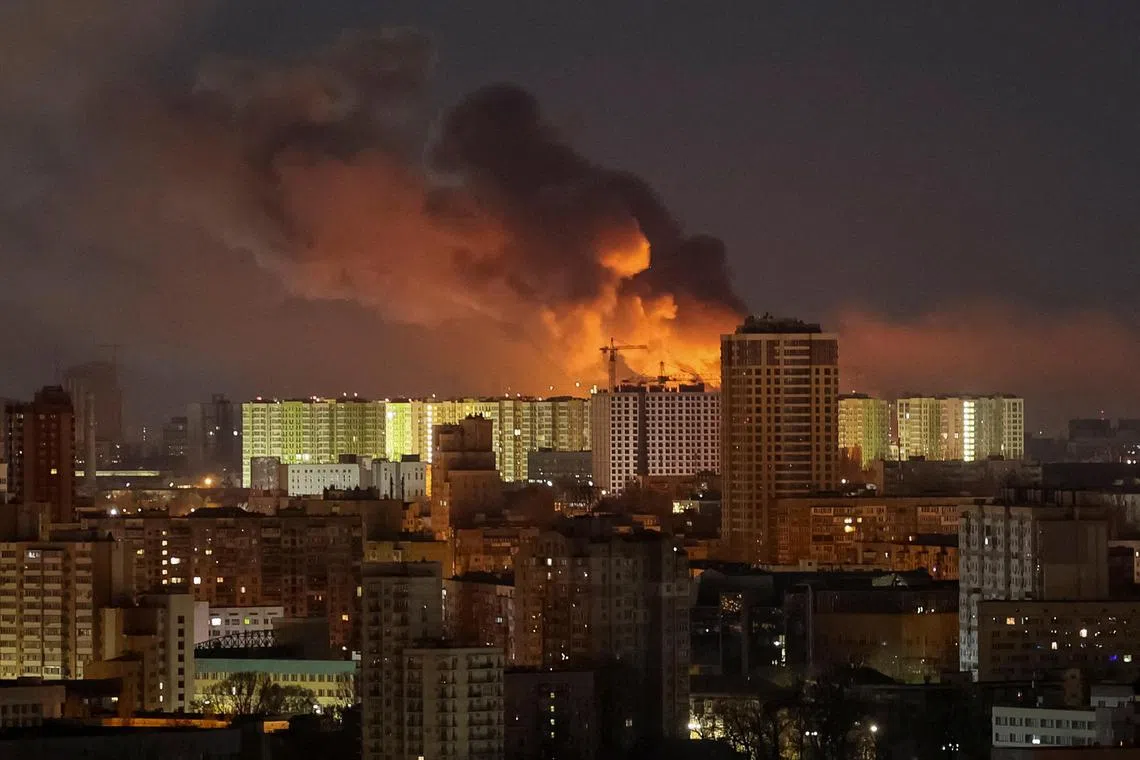Trump envoy suggests allied zones of control, ‘reassurance force’ in Ukraine
Sign up now: Get ST's newsletters delivered to your inbox

Smoke rises in the sky over Kyiv after a Russian drone strike.
PHOTO: REUTERS
Follow topic:
LONDON – Lieutenant-General Keith Kellogg, US President Donald Trump’s special envoy to Ukraine, suggested British and French troops could adopt zones of control in Ukraine.
Lt-Gen Kellogg suggested in an interview with The Times newspaper published on April 12 they could have areas of responsibility west of the Dnipro river, as part of a “reassurance force”, with a demilitarised zone separating them from Russian-occupied areas in the east.
“You could almost make it look like what happened with Berlin after World War II, when you had a Russian zone, a French zone and a British zone, a US zone,” he said, later clarifying on X that the United States would not be providing troops.
“You’re west of the (Dnipro), which is a major obstacle,” Lt-Gen Kellogg said, adding that the force would, therefore, “not be provocative at all” to Russia.
He suggested that a demilitarised zone could be implemented along the existing lines of control in eastern Ukraine, The Times said.
A former acting national security adviser during Mr Trump’s first term, Lt-Gen Kellogg, 80, said Ukraine was big enough to accommodate several armies seeking to enforce a ceasefire.
To make sure that British, French, Ukrainian and other allied forces do not exchange fire with Russian troops, Lt-Gen Kellogg said a buffer zone would be needed.
“You look at a map and you create, for lack of a better term, a demilitarised zone (DMZ),” he said.
“You have a… DMZ that you can monitor, and you’ve got this… no-fire zone,” said Lt-Gen Kellogg.
But he added: “Now, are there going to be violations? Probably, because there always are. But your ability to monitor that is easy.”
Russia launched its full-scale invasion
Lt-Gen Kellogg admitted that Russian President Vladimir Putin “might not accept” the proposal.
‘Reassurance force’
Lt-Gen Kellogg later clarified his position, posting on X.
“I was speaking of a post-ceasefire resiliency force in support of Ukraine’s sovereignty. In discussions of partitioning, I was referencing areas or zones of responsibility for an allied force (without US troops). I was NOT referring to a partitioning of Ukraine,” he said.
Britain and France are spearheading talks among a 30-nation “coalition of the willing” on potentially deploying forces
London and Paris describe the possible deployment as a “reassurance force” aimed at offering Ukraine some kind of security guarantee.
But many questions remain unanswered, from the size of any force, to who would contribute, what the mandate would be and whether the US would back it up.
Mr Putin, in power for 25 years and repeatedly elected in votes with no competition, has often questioned Mr Volodymyr Zelensky’s “legitimacy” as president, after the Ukrainian leader’s initial five-year mandate ended in May 2024.
Under Ukrainian law, elections are suspended during times of major military conflict, and Mr Zelensky’s domestic opponents have all said no ballots should be held until after the conflict.
“If you get to a ceasefire, you’re going to have elections,” said Lt-Gen Kellogg.
“I think Zelensky is open to do that once you get to a ceasefire and once you get some resolution. But that’s a call for the Ukrainian people in the Ukrainian Parliament. Not ours.”
Lt-Gen Kellogg said relations between Ukraine and the US were now “back on track”, citing resumed talks over a proposed deal on Ukraine’s mineral resources.
He said officials would try to turn a “business deal” into a “diplomatic deal” over the coming days. AFP

